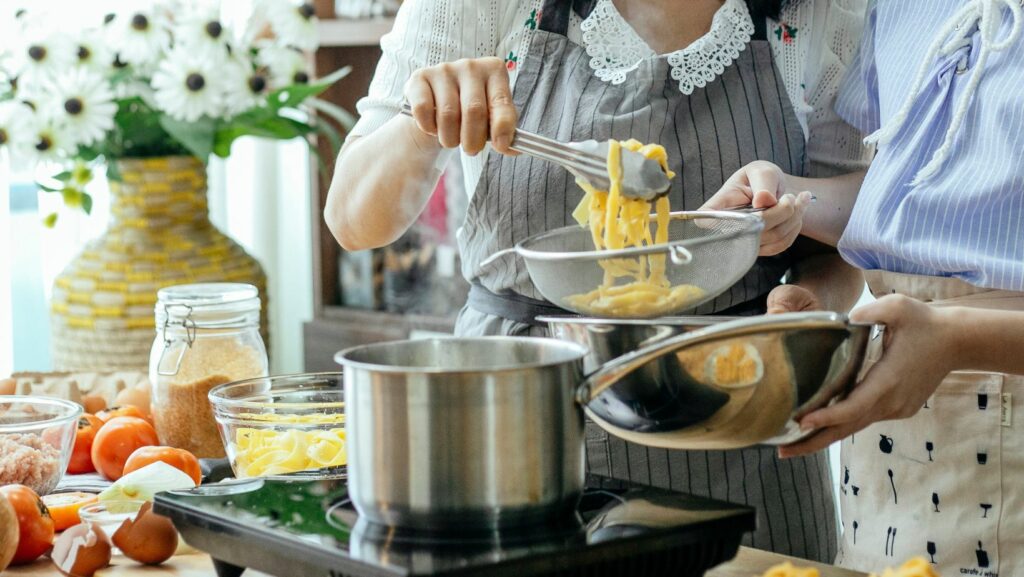Stainless steel cookware, with its sleek design and exceptional durability, is a staple in many kitchens. Yet, it’s not always the easiest to work with, especially for those new to the culinary arts. This article will bring light to the art of cooking with stainless steel, turning your kitchen trials into triumphs.
From understanding the nuances of heat control to mastering the technique of deglazing, we’ve got you covered. We’ll delve into the world of stainless steel cookware, providing practical tips to enhance your cooking experience. So, get ready to take your culinary skills to the next level with our expert advice on cooking with stainless steel.
Tips For Cooking With Stainless Steel

Taking the leap into cooking with stainless steel can be an enlightening culinary experience, providing a unique blend of practicality and elegance. Using these firm, yet flexible cooking vessels can considerably enhance your kitchen journey. This advancement goes hand in hand with understanding the benefits and key characteristics of stainless steel cookware.
Appreciating stainless steel begins with recognizing its numerous benefits. Resistant to rust, stainless steel maintains its shine, leading to years of satisfactory use. Long-lasting for decades, some stainless steel cookware has been reported to display admirable service past the 50-year mark.
The Benefits of Using Stainless Steel
Equally exciting is its non-reactive nature. Stainless steel doesn’t engage with your food, retaining its taste and nutritive content intact. For instance, creamy sauces, tangy curries, and citrusy marinades hold their flavor impeccably in stainless steel pots.
Additionally, stainless steel cookware boasts an innate ability to withstand high temperatures. Imagine searing a thick, juicy steak or blistering vegetables; stainless steel pans perform without a glitch. Moreover, most stainless steel utensils are safe for oven use, allowing a seamless transition from stovetop to oven.
Key Characteristics of Stainless Steel Cookware
Understanding the key characteristics of stainless steel cookware proves vital for improved cooking outcomes. Primarily, they’ve been endowed with a property of poor heat conductivity. This usually leads to hot spots if the heating isn’t done properly, and thus uniformity becomes crucial. Ergo, preheating the pan at medium or medium-low heat for a couple of minutes allows for equal heat distribution.
Layered structure provides another significant characteristic. Premium quality stainless steel cookware generally shows a composition of multiple layers; usually a core of aluminum or copper sandwiched between two layers of stainless steel. This construct boosts its heat conductivity and aids in regulated heating.
Furthermore, cooking with little to no oil is also a possibility with stainless steel. A common practice often entails heating the pan initially, followed by the addition of oil, and then the food. This method, known as the “Hot Pan, Cold Oil” technique, reduces sticking and adds flavor into the food without excessive fat.
In essence, understanding its finer nuances aids in attaining an enhanced experience while cooking with stainless steel.
Essential Tips for Cooking with Stainless Steel

Stainless steel cooking utensils provide numerous benefits, including rust resistance, non-reactive nature, and high-temperature resistance. However, effective use of these tools requires the mastering of critical practices. Three such practices pivotal to cooking with stainless steel include preheating, proper oil selection, and heat management techniques.
Cooking experts consider preheating the pan before adding ingredients an essential step when cooking with stainless steel. A preheated pan gives an excellent sear to foods, particularly important for meats and vegetables with high moisture content. It prevents food from sticking to the pan’s surface, ensures an evenly cooked meal, and enhances the food’s flavor.
Proper Oil Selection
The choice of oil plays a significant role in cooking with stainless steel. Not all oils have the same smoke point or resistance to heat before breaking down. Avocado oil, for example, has a smoke point of 520 degrees Fahrenheit and is suitable for high-temperature cooking. Using such oils with high smoke points minimizes the chances of food sticking to the utensils and promotes better heat distribution.

